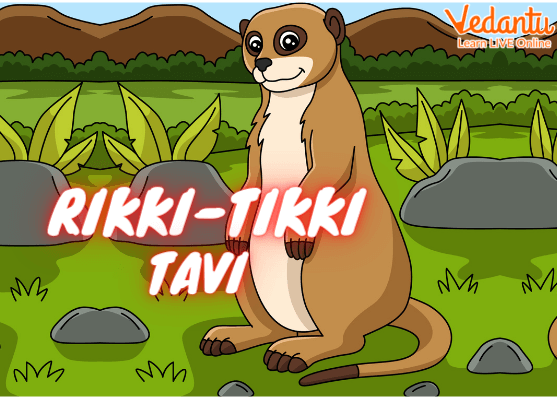The Rikki-Tikki Tavi Story

An Introduction to the Story
Rudyard Kipling's story "Rikki-Tikki-Tavi" is about a brave young mongoose who protects a human family and other animal friends from the vicious, murderous cobras that crawl through the garden.
"Rikki-Tikki-Tavi" is also a short story in Rudyard Kipling's 1894 collection, ‘The Jungle Book’ about the exploits of a brave young Indian grey mongoose. It has been anthologised numerous times and published as a small book on several occasions. The mongoose and snake fable, which influenced the "Rikki-Tikki-Tavi" story, is found in Book 5 of Panchatantra, an old Indian collection.
Let us read the story, its moral and know about the person who wrote it.
The Rikki-Tikki-Tavi Story for Kids
Rikki-Tikki makes friends with a few of the garden's animals. Nag and Nagaina are two cobras that terrify birds and other animals. Darzee, a garden-dwelling bird, and his wife had lost one of their young to the snakes. Darzee pleads with Rikki-Tikki to protect them and their children. Rikki-Tikki chooses to kill the cobras, but not before killing another dangerous snake.
It's his first kill, and his family is incredibly proud of him. He has been recognised as a hero. This simply fuels Rikki-Tikki's desire to kill Nag and Nagaina.

Rikki-Tikki Tavi
Nag and Nagaina plan to kill Rikki-Tikki’s human family one night. While waiting for the man to come in for his morning wash, Nag falls asleep in the bathroom. Rikki-Tikki observes and waits for the proper opportunity to strike. The mongoose defeats the cobra in a bloody battle. After Rikki-Tikki has killed Nag, Teddy's father shoots him in half and tosses the snake in the trash.
Rikki-Tikki and Darzee's wife develop a plan to remove Nagaina from her eggs. Darzee's wife makes a racket to distract the cobra by imitating a broken wing. Nagaina leaves her nest of almost-hatched eggs and pursues the bird. Darzee's wife issues a warning to Rikki-Tikki after he kills the unhatched cobras. Nagaina has cornered the entire family on the veranda, believing the man killed her husband.
Rikki-Tikki taunts Nagaina by bringing one last unhatched egg. She is frantic and begs for her kid to be returned to her. The family is able to flee now that the snake is occupied.
Rikki-Tikki understands that unless he kills Nagaina, neither his family nor the garden animals would be secure. He attacks her and follows her into her underground den. Darzee sings a sad song, claiming Rikki-Tikki must be dead because nothing beats a snake in its own den. Rikki-Tikki, on the other hand, wins and says that Nagaina will not return.
The entire family, as well as the animals, are happy. Rikki-Tikki sits down as the proud protector of his human family and garden-animal friends after a large celebration meal with the family.
Conclusion
The moral of the Rikki-Tikki-Tavi story is to fight fear with bravery and a clear head. If you liked reading the Rikki-Tikki-Tavi story, then check out the amazing animal stories on our website. You’ll also find other interesting reads and poems too.
About the Author
The author, Rudyard Kipling, wrote the story Rikki Tikki Tavi. Joseph Rudyard Kipling was an English journalist, short story writer, poet, and novelist who lived from December 30, 1865, to January 18, 1936. He was born in British India, where he took inspiration for a lot of his work.


FAQs on The Rikki-Tikki Tavi Story
1. Where did the story Rikki-Tikki Tavi take place?
Rikki-Tikki Tavi took place in a bungalow's garden in the Colonial part of India.
2. What is the main idea of the story 'Rikki-Tikki-Tavi’?
The primary idea of the story, '’Rikki-Tikki-Tavi,' is that victory of good over evil is only possible if someone faces their fears with courage.




